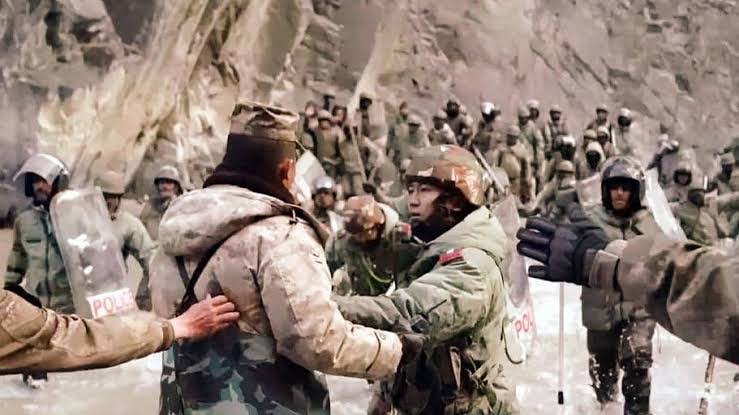China – India relations can move ahead only after Resolving of Indo – Tibetan Border

The joint press release of the 19th round of China-India Corps Commander Level Meeting has been released. The LAC standoff since June, 2020 has yet to see a final resolution.
However, looking at the joint press release issued shortly after the talks and the wording used therein, it is apparent that there has been relatively positive progress in this round of talks.
The two sides agreed to maintain peace and tranquillity on the ground in the LAC areas, and they agreed to resolve the remaining issues in an expeditious manner and maintain the momentum of dialogue and negotiations through military and diplomatic channels.
From the joint press release, it can be deduced that this round of negotiations must have witnessed arduous and intense discussions.
One crucial reason behind India’s tough stance against China is the backdrop of the geopolitical strategic upheaval at the International level. India is determined to turn the World into Bipolar and take its rightful position in world affairs.
India will no longer go along the Chinese “ game “ of business as usual without resolving the physical demarcation of Indo Tibetan Border and China Tibet border.
To India’s advantage there has been a rapid deterioration in China -US relations and simultaneously a rapid improvement in Indo US relationship. In this triangular relationship, it is USA which needs India more than Vice Versa.
A “non-treaty alliance partnership” has emerged between India and the US. Given India’s favourable geopolitical circumstances, China has little choice but to stop playing games.
China must mend its fences, only then it can deal with the strategic pressure exerted by the US in Indo Pacific and Trade deals.
India’s grand strategy is undeniably clear: It aims to put a stop to the Chinese shenanigans on the Indo Tibetan border while simultaneously welcoming the global industry supply chain exiting from China, towards India, achieving economic growth and ascending as a major global power.
However, India is no more worried about the escalation of China-India conflicts, as it is now in a stronger position compared to the PLA’ s Western Theatre Forces.
Any manoeuvring or threat by China will only be beneficial to the Current political set up in India in the upcoming general election next year. In fact any fresh border conflicts would be highly advantageous for the Bharatiya Janata Party in general and PM Narendra Modi in particular. Nothing unites Indians more than external threat.
At present, Chinese are fully aware of intense China-US strategic competition and the ongoing tense high-level communication between the two, and similar level of tension and mistrust between China and other Western nations.
Due to the present LAC standoff and a series of actions by India regarding China in economic and trade cooperation, cultural exchanges, the Shanghai Cooperation Organization, as well as issues related to Taiwan and the South China Sea, China is on the back foot.
The two sides are having one of the most tense relationships among major global powers. China perceives this situation as unfavourable but is in no position to start any kind of mischief, which it does against Taiwan.
Moreover, India holds this year’s G20 presidency, and the Indian side is showcasing its rising power and global status through the G20 summit. China is in so extremely tense state, that it is thinking of not participating in G29 Summit. Though it will not greatly impact the success of the G20 summit.
In a few days, leaders from both China and India will attend the BRICS leaders’ summit in South Africa, and the tense relationship between the two countries may also hinder communication between the leaders.
Indians, have always hoped for stable and developing peaceful relations with China. Both must peacefully resolve the LAC issue to start with and next the Indo Tibetan border issue, followed by China Tibet border. However the crux lies in China’s obsession and unreasonable action of forcibly occupying Tibet, a free country.
After multiple rounds of military commander-level talks, both China and India have disengaged in places like Galwan Valley and the north and south banks of Pangong Lake.
However, China has to restore the situation in the border areas to the status quo before April 2020 as a precondition for easing bilateral relations.
The Indian military has maintained a large-scale deployment in the border areas. Unless China does this, relations in other sphere cannot start moving forward.
From the joint press release, it’s clear both China and India, from the perspective of the whole picture of China-India relations, have had a positive, constructive and in-depth discussion and exchanged views in an open and forward-looking manner, indicating that both countries indeed hope to find mutually acceptable ways and means to resolve the remaining issues in the border areas.
The settling of the LAC issue is the precondition for further development of China-India relations. In this regard, China has a lot to do.
Finally, the joint press release specifically mentions “in line with the guidance provided by the leadership of the two countries,” which makes us realize that the leaders of China and India can still play the role of helmsmen in the development of bilateral relations. The direction of China-India relations will not be lost or even collide head-on.



